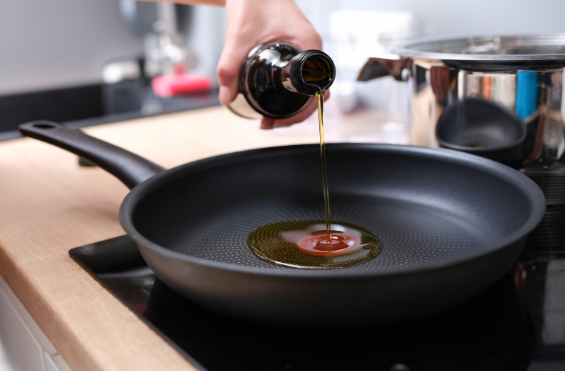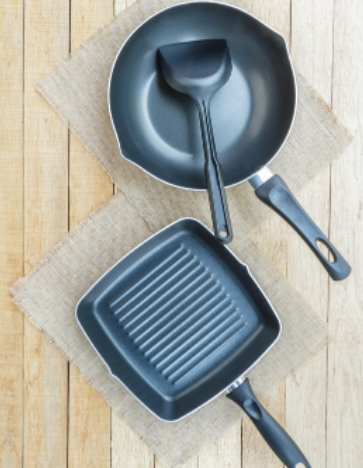Ceramic Pan vs Teflon Pan: Regardless of whether you’re someone eager to cook healthy meals for yourself or your family, you may already be confused about various cookware options out there. They’re, for example, skillets, frying pans, woks, and many more.

So, it’s obvious that you cannot imagine a kitchen without these pieces of cookware. Otherwise, you have to feed on only boiling or poaching most of your food, or you need to turn yourself out to be an ancient caveman and eat all your food by cooking them with fire.
But, the reality is not something like that, and you need, at least, a quality frying pan to cook the day-in, day-out, can-do items. Therefore, when you’re in the market to purchase a new frying pan, you might be bewildered at plenty of available alternatives.
What Is the Main Difference Between Camp Chef Ands Blackstone Griddle?
Choosing the right piece of cookware among them can really be a hard nut to crack. It’s quite challenging to decide on opting for a particular pan. This is why we’re here to help you out of the dilemma, answering to the question, “Which pan is better: Ceramic or Teflon?”
That’s the exact question that provokes you to come to this article. Apart from the nonstick capabilities, both pieces of cookware have their own pros and cons. In our opinion, you should prefer the pan that fits your kitchen necessities better.
What is a Ceramic Pan?

Even though many people kept a ceramic flower pot in their home, they couldn’t have imagined that cookware would be made of ceramic, and this type of cookware would become one of the best nonstick kitchen appliances.
Ceramic pans are nonstick because they’re coated with silicon dioxide and the encapsulated oleophobic and hydrophobic chemicals by applying to them via a spray or dipping them into the solution. Therefore, they become water and oil-resistant.
Besides, ceramic pans are a good heat conductor that allows you to keep cooking your meal for a few minutes after removing the pan from the stovetop. You shouldn’t use these pans at higher temperatures because they could break down.
However, some manufacturers nowadays add more ceramic layers to these pans so that they cannot break, although you put them in cold water when they’re super-hot. Unlike Teflon pans, ceramic pans don’t release toxic fumes while something is being cooked on them.
The vast majority of ceramic pans are not dishwasher and oven-safe. Only a few brands make multi-layered ceramic pans, and therefore, they’re dishwasher and oven-safe. Although these are not as durable as Teflon pans, they last for years if you properly care for them.
Is Ceramic Pan Safe?
The Food and Drug Administration (FDA) of the United States tested various ceramic coated cookware and found lead and cadmium in certain products. If these substances leach into your food, and therefore, go to your stomach, they’ll probably have tremendous health hazards.

Although lead is dangerous stuff, you don’t need to panic because all manufacturers in the United States are using lead-free coating when they’re producing ceramic cookware.
So, buying a ceramic pan from a store is absolutely safe these days.
According to the FDA, if you’re cooking with a full ceramic dish, a ceramic antique, a hand-made ceramic item, a chipped or damaged ceramic pan, or a ceramic pan purchased from an unauthorized seller, then you have to worry about your cookware.
Finally, you have nothing to worry about ceramic pans because they’re manufactured following strict regulations and health concerns in mind. Just follow the proper instructions for ceramic pan usage. Be aware of exceeding the heat limits.
What is a Teflon Pan?

Teflon is a company that has been producing nonstick cookware for a long time.
This brand uses PTFE, made of a synthetic polymer, on their pans as a nonstick coating, which is the short form of Polytetrafluoroethylene.
Now, the well-known name of this substance is Teflon.
For your information, PTFE was first introduced in 1938 by the DuPont Corporation. In the 1950s, nearly a decade later, this substance was patented as Teflon and applied to cookware, especially pans and skillets, so that food doesn’t stick to the surface.
Typically, most Teflon pans are designed with durable aluminum or steel material with multiple coating layers to make them completely nonstick. When these pans were first marketed, people loved them a lot. They were able to cook a variety of meals with a small amount of oil.
These excellent pans tend to be a bit risky if you overheat those over 500 degrees Fahrenheit. Nonstick coating may leach into your food while cooking. Besides, if you’re cleaning them using a metal brush, Teflon pans may loosen up the coating.
However, Teflon pans have been considered as cookware that had health and environmental concerns over the years. As a result, many people have changed their minds and turned their attention to ceramic pans. Let’s see whether Teflon pans are safe these days.
Is Teflon Pan Safe?
Teflon pans are not 100% safe due to two human-made PFOA and PTFE chemicals. PFOA was previously used in making Teflon Pans. When this substance was proved to be harmful to human health, it was phased out in 2015 and is now no longer used in these Pans.

As you know, the nonstick surface starts degrading and emitting toxic fumes when Teflon pans are heated over 500 degrees Fahrenheit. In some cases, handles and lids can withstand fewer temperatures, only 350 degrees Fahrenheit.
Besides, suppose you’re heating one of them around 700 degrees Fahrenheit. In that case, it will begin to emit six toxic gases, such as carbonyl fluoride, carbon tetrafluoride, Carbon dioxide, Perfluoroisobutene, Trifluoroacetic acid, Difluoroacetic acid, and Monofluoroacetic acid.
The best part is the claims that Teflon isn’t proven to cause cancer. But, they identify that the materials used in Teflon pans are harmful to human health. Now, the solution is you have to cook any recipe on a Teflon pan using medium heat.
Ceramic Pan vs. Teflon Pan: Key Differences Between Teflon and Ceramic Coating

Now, you know what Teflon and ceramic pans are. Both nonstick pans have their own benefits and drawbacks. So, before you’re choosing either option, scroll down to check out the key differences between these two types of pans.
Safety
When it comes to safety, Teflon is not an ideal option. As you know, it’s made of PTFE that can emit toxic fumes when it’s on high heat. However, the chemical doesn’t react with food if you’re heating it on medium or low flame.
On the other hand, ceramic is made of natural minerals that can withstand more heat than Teflon. Although ceramic pans are prone to leaching toxic substances in food, they’re much lesser than Teflon pans. So, you should go with a ceramic pan.
Durability
In terms of durability, both ceramic and Teflon pans usually last for 3 to 5 years, but the lifespan can increase depending on how well you treat them. However, their nonstick coatings tend to get scratched and become less effective over time, even if you’re pretty careful about them.
Teflon pans made of at least 3- layers of PTFE usually last longer than ceramic pans. This is why these pans come at a higher price range. If Teflon pans are designed with only a single layer of the silicone polymer, they’ll be the same durable as ceramic pans.
Nonstick Capabilities
As you already know, both ceramic and Teflon pans usually come with superb nonstick capabilities. On these pans, you can prepare various food without using much oil and worrying about sticking food to the pan’s surface.
If you compare them in terms of nonstick capabilities, ceramic pans are considered better nonstick pans than Teflon ones. However, keep in mind that the more the number of the coats a ceramic pan has, the more nonstick it will be.
Heat Retention Capability
If cooking time is your main concern when choosing a piece of cookware, you’ll always need a pan that makes your meal as quickly as possible. Although ceramic pans heat up slowly, they’re a good heat conductor. In contrast, Teflon pans have poor heat retention capability.
Ease of Cleaning
Cleaning both Teflon and ceramic pans is quite simple. Once you’ve finished cooking on your pan, you just have to wipe the surface with a kitchen towel or a soft sponge. However, Teflon pans might be a bit difficult to clean due to their hard anodized coatings.
Price
Price is one of the major concerns when choosing a nonstick pan. Fortunately, nonstick pans are less expensive than pans of other materials. Ceramic pans are usually more expensive than Teflon pans of the same quality, although it depends on the particular brand and product.
Final Words
In a nutshell, both nonstick pans have different coatings on their cooking surfaces. The nonstick coatings of ceramic pans are natural but fragile, while Teflon pans have artificial nonstick coatings that tend to peel or flake.
| Feature | Teflon Nonstick Pan | Ceramic Nonstick Pan |
|---|---|---|
| Safety | Emits toxic fumes on high heat (PTFE-based) | Made of natural minerals, safer on high heat but can leach fewer toxins into food |
| Durability | Lasts 3-5 years, longevity depends on care | Lasts 3-5 years, can vary with care; multi-layer Teflon lasts longer but more expensive |
| Nonstick Capabilities | Good nonstick, may wear over time | Good nonstick, may improve with more layers of coating |
| Heat Retention | Poor heat retention | Heats up slowly but conducts heat well |
| Ease of Cleaning | Simple cleaning, hard anodized coatings | Simple cleaning |
| Price | Generally less expensive | Usually more expensive than Teflon, varies by brand and quality |
In both cases, these nonstick pans last for only 3 to 5 years if you properly care for them. The short lifespan is the main weakness of these coatings. If you want your pan to last for more years, you should avoid using metal utensils while cooking something on these pans.
You may also like to read
- Vintage Cast Iron Skillet
- Enameled Cast Iron Skillet
- Cast Iron Skillet for Glass Top Stove
- Broiler Pan
- Cast Iron vs Stainless Steel Pan

Hello! I’m Paula Deen, a mother who loves to create memories in the kitchen. As a kitchen enthusiast, I love to do experiment with different kitchenware for daily recipes. This is my blog, where I’ll share my experience, knowledge, and reviews on various kitchenware and appliances.